How to TIG Braze a Knife Handle
Video shows How to TIG Braze a knife handle on a file to make a Trench Knife
How to TIG Braze a Knife Handle Read More »
Video shows How to TIG Braze a knife handle on a file to make a Trench Knife
How to TIG Braze a Knife Handle Read More »
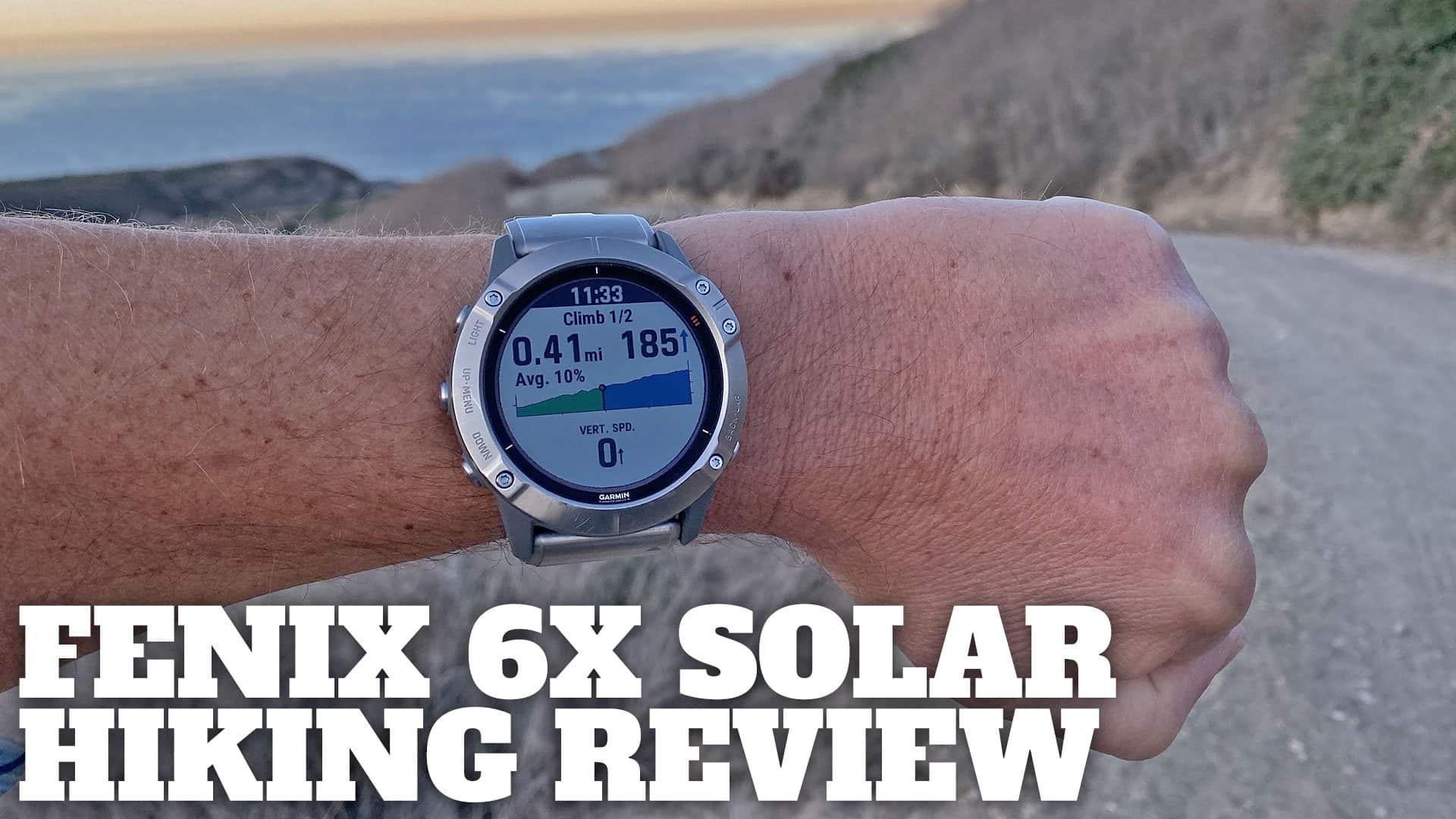
Okay, spoiler alert, the Fenix 6 is a great, if not the greatest, outdoors watch so far. In this review and how-to guide I’m going to focus on the hiking and outdoors applications of the Fenix 6. I’ll be specifically using the Fenix 6x Pro Solar, which I’ve had on my wrist 24/7 since the day it came out. I’ve owned every Fenix model since the 3, and the 6 Pro Solar doesn’t disappoint.
The post Garmin Fenix 6 In-Depth Review appeared first on HikingGuy.com.
Garmin Fenix 6 In-Depth Review Read More »

It’s hard to be a Hiking Dude if you can’t navigate your way through the wilds. So, I spent my Saturday morning with a great group of Women Who Hike helping them hone their map and compass skills. The morning started a little drizzly but turned into a beautiful fall day to spend out in nature.
We met at a local nature center and spent almost two hours learning what a compass does (and does not do), how to take a bearing, orient a map, read topographic features, find direction without a compass, and following directions for specific distances. I thought it was a pretty packed morning and I really enjoyed meeting some new friends that I hope to see out on the trails.
Much of the information we covered comes from Compass Dude and there is a lot more detailed compass knowledge there, including some activities to try.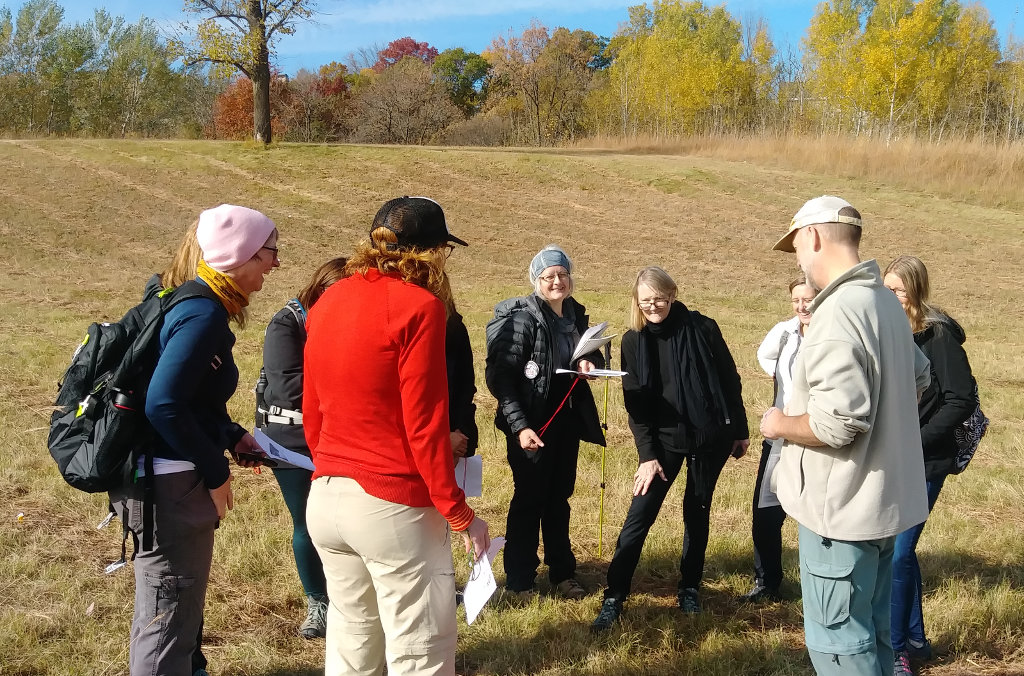

Once everyone was comfortable using their compasses, we played a compass game for about 15 minutes. They all said it was helpful in driving home the skills of following a bearing and estimating distance. You can print the Compass Game if interested. The winning pair of women each received a ‘compass’ merit badge.
It was nice that the sun came out to help with telling direction without a compass. We showed the Shadow Stick method, Moon method, and Wristwatch method because GPS devices can run out of electricity and compasses can break on rocks. Being able to estimate directions with no tools might be important some day.
If you’re a woman looking to start hiking, or looking for some friends to hike with, check out the Women Who Hike website or Facebook page. They have chapters in every state and tend to be a very supportive, helpful group.
Hike On!
Security overload leads to apathy. How often do you hear a car alarm go off and roll your eyes hoping the owner would disable the blasted thing before the incoming headache comes a knocking? The primary objection I have to such systems is they work too well. Every week I hear an alarm being triggered […]
This is just the start of the post Security Information Overload: From Panic to Apathy & the Remedy. Continue reading and be sure to let us know what you think in the comments!
Security Information Overload: From Panic to Apathy & the Remedy, written by Thomas Xavier, was created exclusively for readers of the survival blog More Than Just Surviving.
Security Information Overload: From Panic to Apathy & the Remedy Read More »
Biolite contacted me to see if I’d check out some of their products and put the word out about their preparedness month kits (you did know September is Preparedness Month, didn’t you?).
You’re reading BioLite Preparedness Kits, originally posted at Graywolf Survival – Emergency preparedness from a Counterintelligence Agent by Graywolf.
BioLite Preparedness Kits Read More »
Over 100 speakers will take to the stage and thousands of visitors are expected to listen to the talks. The event will take place from 19 – 21 May, at ExCeL London, and speaker applications are open until 31 January.
The post Safety & Health Expo is looking for speakers. Are you interested in joining the line-up? appeared first on SHP – Health and Safety News, Legislation, PPE, CPD and Resources.
Safety & Health Expo is looking for speakers. Are you interested in joining the line-up? Read More »
Modern pistol design has embraced the striker-fired action as the current paradigm. There are good reasons for this, greater mechanical simplicity and a moderate consistent trigger pull being two of the most common.
Of course, the blockbuster success of a little pistol called the Glock (though not the first striker fired handgun by a long shot) also contributed much to the rise of this action.
Simply put, hammer-fired pistols are starting to go by the wayside, even as they see a minor resurgence among certain enthusiasts and connoisseurs.
More than a few shooters see hammer-fired guns as more work than they are worth whatever their other qualities are, either in the form of additional controls like safeties and decockers or a more complex manual of arms thanks to having two distinctly different trigger pulls in a DA/SA pistol.
In the famous words of one lady who became a beloved meme, “Ain’t nobody got time for that!”
This is regrettable because in the pantheon of pistols one design is uniquely well suited to the demands of defensive use of a handgun, not just mere shooting: the double-action single-action pistol.
Sometimes regarded as the “other” hammer-fired pistol type, this unique and occasionally maligned action brings a lot to the table in both safety and performance for those willing to put in the time to master it.
n this article, I’ll talk about a few perks you probably did not know about with pistols of this type and give you some pointers on how these guns can work for you. It’s time to stop worrying and learn to love the hammer.
Arguing about guns never ceases to entertain. I am sure that wall the back in the dark days of history when the first primitive handheld guns were invented, and there was more than one model to choose from, people argued their comparative merits.
It’s just human nature I suppose. No matter how far our technology, metallurgy and design parameters pertaining to firearms have evolved, there are a couple of fundamental principles, rather characteristics that a defensive handgun must possess before any others in order for even warrant entrance into the brutal calculus of lethal force self-defense.
The key absolute is mechanical reliability and durability. A gun that is fussy, fragile or otherwise questionable when it is time to make it go bang is no gun you want to bet the farm on.
A defensive gun must also be possessed of adequate caliber for defense (against humans in our case) and should be designed in such a way that its controls are easily actuated without undue fretting and fumbling from the user. Not all designs kept foremost the human element among its tenets.
Why does all this matter for our discussion? Because frankly without those fundamental elements- reliability, adequate performance, ease of use- than no other quality matters. Without those bedrock characteristics for selection in place affirmatively, you should not consider a gun so lacking for self-defense.
I am here to tell you there are many DA/SA pistols on the market that have these vital traits, both new designs and older ones. So that being so, the question is now whether or not the action itself the reason to choose or disqualify an otherwise excellent gun from service? Another question: does a DA/SA gun bring anything to the table a striker gun does not?
The current gestalt among pistol shooters is that striker gun-equals-better gun for all the reasons I mentioned above; simpler, consistent, easier to shoot, etc.
Are those qualities all that matter in a defensive gun? Is raw “shooting” performance the first and only barometer of a good defensive gun?
I say no, that while it is certainly important there is far more that can and will occur when it is time for you to defend your life with a gun in hand, and the design and operation of that pistol will either contribute to keeping you safe or help set you up for failure.
There is a lot to unpack in that assertion and I’ll do so in the next section.
As with any gun, DA/SA pistols have their own legion of detractors who think they are just the worst. Some of these critiques are based in fact or experience and must not be discounted out of hand. Others are little better than propaganda and deserve to be put down with authority.
I have little doubt you will have heard the most common complaint before, but I feel it is important to unpack this claimed flaws fairly before making my case for pistols of this type.
By far the most common gripe concerning DA/SA guns is that they are simply too hard to shoot well and too complicated to use thanks to a complex and error-prone manual of arms.
A heavy first trigger pull, the subsequent light trigger pulls, plus you have to remember to decock when you are done, and then there is also potentially a safety to worry about! Sheesh! Let me get the flowchart for my gun!
Critics claim this alone makes DA/SA pistols a poor option because they are so hard to shoot in addition to training time needed to master them being excessive compared to other pistols.
My opinion? Yes, DA/SA guns do indeed take more work to shoot well than guns with light, crisp, consistent triggers. NO two ways about it. How much more work, though?
That is tough to say. There is no quantified data set for that among trainers, but in my own experience teaching I would say the average shooter needs only about 10-15% more effort and reps invested to attain near parity with guns utilizing a consistent trigger.
Two major contributing factors to reaching competency with a DA/SA pistol is 1.) optimized techniques for shooting a DA/SA gun well and 2.) the gun itself is possessed of a decent trigger.
I’ll assert plainly that you do not shoot all guns the same way. Sure, the fundamentals of marksmanship don’t change, but the way we attain them may.
A student with a DA/SA semi or DA revolver whose teacher preaches the old dogma of placing just the tip of the trigger finger on the trigger to shoot will quickly become frustrated with their lack of performance and annoyed with how difficult the gun is to operate.
You don’t pull one of those longer, heavier triggers the same way as you would a custom 1911 with a 3 lb. trigger. More leverage is needed to yield the control required to move these heavier triggers to the rear consistently.
The trigger itself is particularly important on a DA/SA pistol. Weight is often emphasized here, with lighter being better (and it often is) but of even greater importance is that the trigger be smooth and hitch-free.
A smooth, consistent trigger is easy to manage and shoot well with just a little bit of practice, even for beginners. Paying proper attention to grip and trigger finger placement is easily taught and more importantly easily executed. After that first shot and the gun transitions to single action mode most students are in for smooth sailing.
As far as the rest of the case against DA/SA pistols having a complex manual of arms, I refuse to subscribe to that notion in any way. Compared to the majority of striker-fired pistols that lack decockers or manual safeties, sure, a typical DA/SA gun is more complicated… By a matter of exactly one extra step!
Critics of these pistols would have you believe that running one additional switch, the decocker or safety-decocker, at the conclusion of shooting is simply too great a burden to bear and too hard to teach to your average adult.
This is hogwash. Yes, it must be taught, but the notion that this single extra step is beyond the capability of an armed professional or civilian of average intelligence has little grounding in reality.
DA/SA pistols are more complicated than typical striker fired guns, but this is a matter of inches and feet, not miles. Might that complexity render it a poor choice for some shooters? Sure, but it is in no way so complicated that even halfway decent instruction and practice will render its operation second nature.
A longer, heavier trigger is more likely to prevent an unintended discharge than a lighter one. No two ways about it. If a finger or foreign object should make its way into the trigger guard when no shot is intended and begin to apply pressure to the trigger, a short, light trigger will result in a discharge more often and more quickly than the aforementioned long pull. I can hear some hate simmering in the comments already…
I have heard from many peers, readers and dissenters who proclaim any modern handgun more than safe enough irrespective of action if only the user is well trained enough to keep their stinkin’ finger off the trigger. That is the key absolute to safety, they say, and will hear no discussion to the contrary.
Fair enough. Most unintended discharges are indeed negligent instead of truly accidental so their claim has merit. But what if I told you that their entire premise is a flawed one? And more than that that the vagaries and stress of a life-or-death encounter means managing your pistol entails far more than just getting a short mouse-click trigger press before sending lead downrange?
While I do not doubt that many readers are extremely well trained and take their practice as seriously as life itself, I do doubt very much their claims of flawlessness, that they won’t make mistakes and that sheer bad luck has never overtaken them.
I have trained and trained with too many shooters who I would consider excellent and reviewed too much video of both live events and seriously high-pressure force-on-force training to believe in perfection when it comes to trigger finger discipline any more.
Whether from extreme stress, fatigue or fear, a curious phenomenon manifests itself in these situations, which is that of the shooter quickly, briefly placing their finger down onto the trigger seemingly in an effort to ascertain that it is still there.
This pre-emptive positioning most often occurs with the shooter having no conscious knowledge of it occurring. During a later debrief when it is brought up to them they swear on all that is good and holy that they did no such thing.
But cameras do not lie, and the proof is positive: this curious glitch whatever you care to call it does occur, and should it happen on a gun with a light, short trigger when muscles are tense or the shooter is startled the result can be an ND.
The long, heavy pull of the first DA shot provides more feedback to the shooter between pressure accumulating on the trigger and bang that “something is happening,” and this can be enough to correct the deficiency.
Furthermore, a long trigger pull can allow a shooter to back off of a trigger in time before breaking the shot should the need to shoot vanish or new information change the scenario.
With light single-action and striker-fired pistols there is precious little that happens between “decision to fire” and “bang,” and while a double-action pull does not take that much more, it is sufficiently long and tactile to allow a shooter to cancel the shot should the need arise.
This is of special interest anytime you have a threat at gunpoint and are attempting to gain compliance or talk them down. You may be entirely warranted to have a bad guy at gunpoint and have your finger on the trigger, but that does not mean that you will be forgiven of any discharge classified as accidental or errant.
Your finger may move from the trigger to the frame and back again several times before that first, fateful shot is fired as the situation ebbs and flows. Remember: you will handle and point your pistol at people far more often than you will actually shoot it at people. I definitely want a trigger that will back me up in that regard.
Of course once the fight is on and the first shot is made, a DA/SA gun switches to single-action mode for subsequent shots. Here is another payoff of the system.
The light, crisp follow-up trigger pulls of the DA/SA pistol lend themselves to fast and accurate shooting once the conscious decision has been made to fire.
Once a shooter is acclimatized to it, the DA/SA system offers a best of both worlds: the inherent safety of a longer, heavier trigger pull as a hedge against unintentional discharges and the light, short single action pull for continued shooting. Once the fight is over, or over for the moment, the gun is decocked and the process begins again.
Somewhat akin to a stick shift in a car, a DA/SA pistol gives its user a greater degree of mechanical control over its functions. The exposed hammer of your typical DA/SA pistol can be physically restrained by the shooting hand thumb when holstering in order to completely block its reward travel in case something (like a finger or coat pull) should impinge on the trigger when holstering.
Remember, actuation of the trigger cocks and releases the hammer in double-action mode, or just releases it from the cocked position in single-action mode.
In either condition, the thumb can prevent hammer movement, thusly preventing discharge, and in the case of the hammer being cocked to the rear it is immediately apparent that the shooter skipped decocking of the gun before moving to holster.
Compared to a striker-fired pistol where, aside from the trigger, all the magic happens within the slide and frame the DA/SA pistol used properly provides true reassurance against an unintended discharge upon reholstering.
Once again, it is too easy to proclaim that it won’t happen to you, that you are safe, reholster carefully and verify the mouth of the holster is clear of any obstructions before proceeding. Yeah, you are that good, or maybe it is just hubris worming its way into your mind.
If this capability was only a fringe benefit as some have suggested why would companies like Tau Development group and their Striker Control Device, or “Gadget” be gaining a small but vocal and legitimate group of expert striker gun users in professional circles?
The Gadget, in case you are unfamiliar, is a replacement backplate for Glocks that features an articulated hinge or button that is depressed by the user’s thumb during reholstering in order to prevent the striker from moving to the rear, which in turn prevents the trigger bar from moving which in turn halts the trigger itself. This akin to what your thumb should do when holstering a gun with a hammer and accomplishes the same thing.
Sounds like capability like that is, perhaps, a good thing to have during what is statistically one of the most dangerous operations you can perform with your pistol- holstering it. Something to think about.
I do not deny that the striker-fired pistol is here to stay, and for good reason. I also do not deny my preference for traditional double-single pistols. For me, a DA/SA gun is no impediment.
Quite the opposite, a DA/SA pistol provides me capability that I frankly cannot get out of an average Glock or other striker-fired pistol without some significant modification and installation of one nasty trigger.
My trusty pistol can certainly bite me, and it is more likely than any other time when I am handling it administratively, that is in a non-fighting or non-shooting task. Well, any administrative task can become a shooting task if the gun is loaded…
For that reason and for the added assurance during a fight, or the buildup to a fight I prefer having a double action first shot for safety and at the same time having the pistol ready to fire instantly. Again, best of both worlds.
When the time to shoot is nigh, I don’t sweat that heavy pull; my pistol has no action enhancement, but from plenty of practice and plenty of rounds fired that DA pull is as smooth and crisp as I could practically want. It is like it is not even there.
After that first shot, the single action trigger pulls on my Sig are excellent compared to nearly any striker gun trigger; a bit of take-up, a well-defined wall and a crisp break with just a hair of overtravel.
More than adequate for fast and fancy accurate shooting, and I have proven as much in plenty of matches and training classes. You’ll find only a few striker-fired pistols with stock triggers that can match the average DA/SA gun in single action mode.
The ability to physically block the gun from firing when holstering is something I am adamant about. There has yet to be one person who can adequately explain how this is anything but a very good thing.
Holstering a pistol is always fraught with peril as I said earlier, and anything I can do to mitigate this peril especially when carrying IWB, especially when carrying AIWB, is an advantage you’d be smart to utilize.
So bottom line, with just a little more practice I can have a pistol that is safer and more forgiving of mishaps than a striker-fired pistol, that is still reliable and still a superbly capable shooter.
What is not to love? Forget what you think you know about this classic action and get ready to drop the striker gun so you can drop the hammer.
DA/SA guns are seeing resurgence in popularity but are still a long way from their heyday. Nonetheless, for discriminating pistol shooters the unique combination of advantages afforded by these guns adds up to more than the sum of its parts.
Hammer guns are not dead, far from it, and if you are willing to spend some time learning to run one properly, you might find its combination of assurance, safety and performance to be the ideal set of traits for your self-defense pistol.
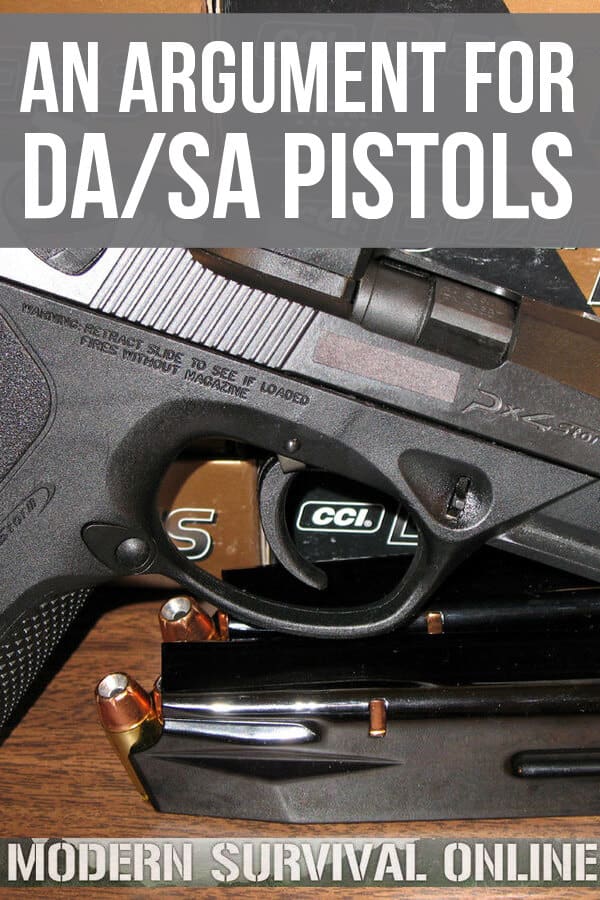
An Argument for DA/SA Pistols Read More »
I finally made it to Regina this past summer – the last of the Canadian cities for me to visit. Even though Regina is a prairie city, it’s green and lush thanks to 350,000 hand-planted trees. With truly fabulous restaurants, a passionate fan base for the Saskatchewan Roughriders football team and one of the largest urban parks in North America, I’d certainly recommend a visit.
Here’s what you can do in the city- 8 Awesome Things to do in Regina Right Now

Walter Scott – the first premier of Saskatchewan
1. Regina became the capital of Saskatchewan in 1905.
2. Regina started off as a hunters’ camp in the 1880’s. Back when the buffalo still roamed the prairies it was called Pile O’Bones for all the bones left there after skinning and cutting buffalo.
3. Regina is the 16th largest city in Canada. The population of Regina as of July 1, 2018 was 257,337 people – according to Statistics Canada. Its growth rate is about 2.2%. Of that 14% are 65 years or older. Eighteen percent of the population is under 15 years of age.
4. Regina sits at an elevation of 577 metres above sea level. It’s mostly flat with a maximum elevation change of just 43 feet within 3.2 km of Regina.
5. Regina is the closest city to the centre of North America.
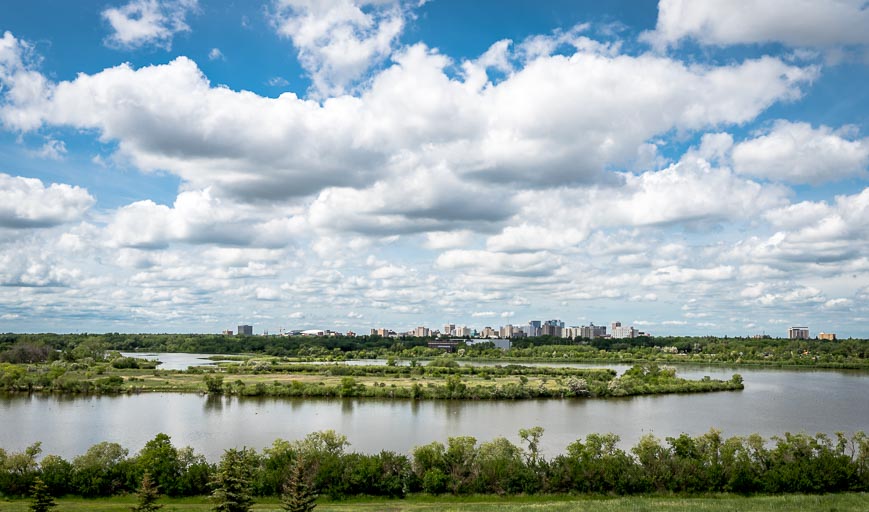
View of Regina – and it sure does look flat
6. Of the top 500 corporations by revenue in Canada, five are headquartered in Regina. They include Crown Investments Corp. of Saskatchewan, Saskatchewan Worker’s Compensation Board, the Saskatchewan Auto Fund, Saskatchewan Liquor and Gaming Authority and Saskatchewan Telecommunications Holding Corporation.
7. The hottest temperature ever recorded in Regina was 43.3°C on July 5, 1937.
8. Regina usually endures 201 days a year when the minimum temperature is at 0 °C or below.
9. The length of the day in Regina is highly variable. On the summer solstice Regina gets 16 hours, 27 minutes of daylight. On the shortest day of the year it gets 8 hours of daylight.
10. In Regina – and all of Saskatchewan daylight savings time is not observed.
11. The earliest sunrise is 4:46 AM on June 17th. The earliest sunset is 4:54 PM on December 12.
12. Canada’s deadliest tornado spinning at a speed of 400 km/hour occurred in Regina on June 30th, 1912. It killed 28 people and destroyed a lot of the town. In fact it took two solid years to make all the repairs but 40 years to pay it off.
13. Every last one of Canada’s Royal Canadian Mounted Police have undergone a rigorous six-month training program at Regina’s RCMP Depot. They’ve been doing it in Regina since 1885. Take a tour to learn what it takes to become a Mountie.
14. Louis Riel was hanged for treason on November 16, 1885 at the North-West Mounted Police barracks in Regina.
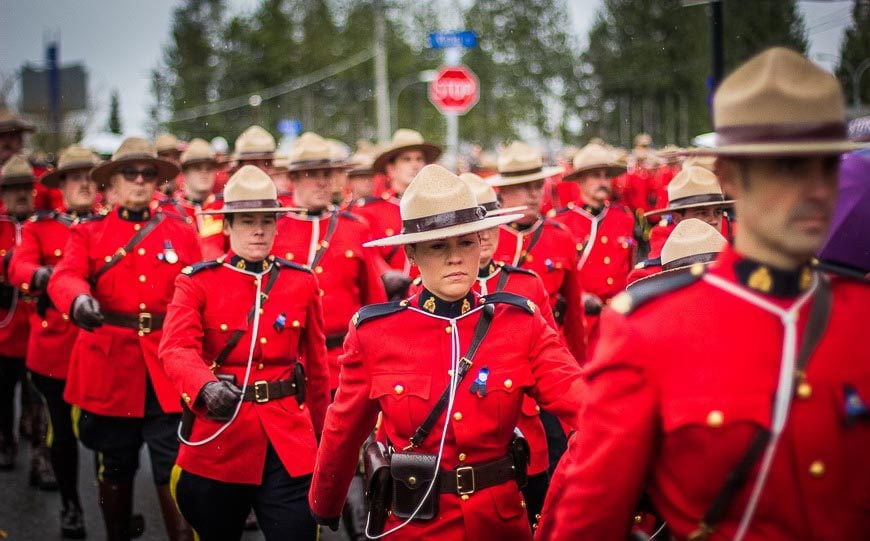
The RCMP Mounties – Photo credit: Nic Amaya on Unsplash
15. The longest running historical theatre production in North America – the Trial of Louis Riel is reenacted every summer in Regina by local performers. The play, written in 1967, is based on the original transcript from the trial of 1885.
16. The first Gay Pride Parade in Regina was held in 1990. You could still discriminate against somebody in Canada for their sexuality so parade participants covered their faces with masks to avoid detection.
17. Regina is synonymous with football. The Saskatchewan Roughriders are a good team but their fans, Rider Nation are tops. In fact of all Canadian sports teams including hockey, the Roughriders have the third highest merchandise sales. At a roughriders football game you can expect to see fans sporting real watermelon helmets and pilsner beer capes.
18. Regina’s Wascana Centre, built around Wascana Lake is huge, as in bigger than Vancouver’s Stanley Park and New York City’s Central Park combined.
19. Wascana Lake was created in 1883 by damming Wascana Creek.
20. In 1961, Minoru Yamasaki, the architect who designed the original World Trade Center in New York City, was commissioned to prepare a 100-year master plan for all of Wascana Centre.
21. At the western edge of Wascana Lake look for Albert Street Memorial Bridge. It’s the longest bridge over the shortest span of water in the world.
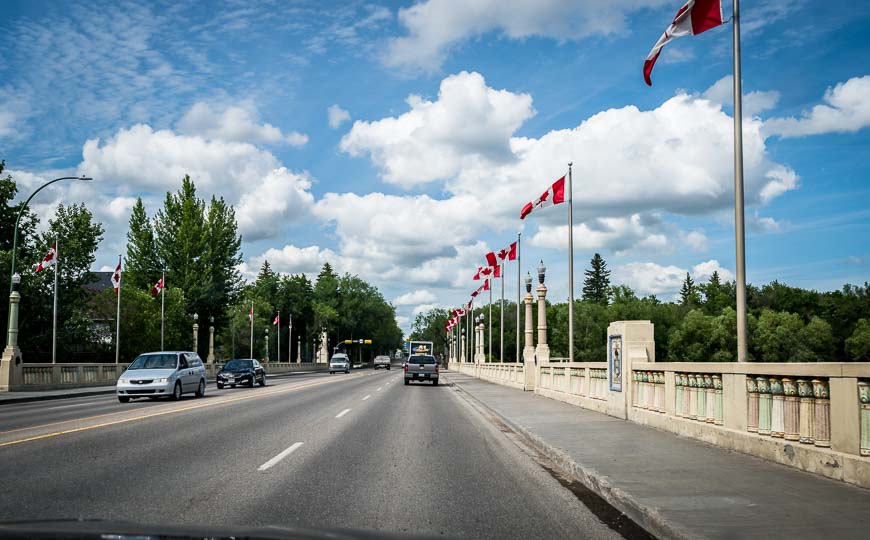
The longest bridge over the shortest span of water in the world
22. Wascana Park provides free grain to feed the birds. Head for the Waterfowl Display Ponds across from the Conexus Arts Centre. Feed Stella the swan along with huge numbers of Canada geese and ducks. You are encouraged to bring leafy greens for the birds but not bread as it isn’t good for them.

No shortage of Canada geese in Wascana Centre
23. Wascana Lake beckons outdoorsy types. You can rent kayaks and SUP’s and explore the lake on one of Regina’s numerous sunny days.
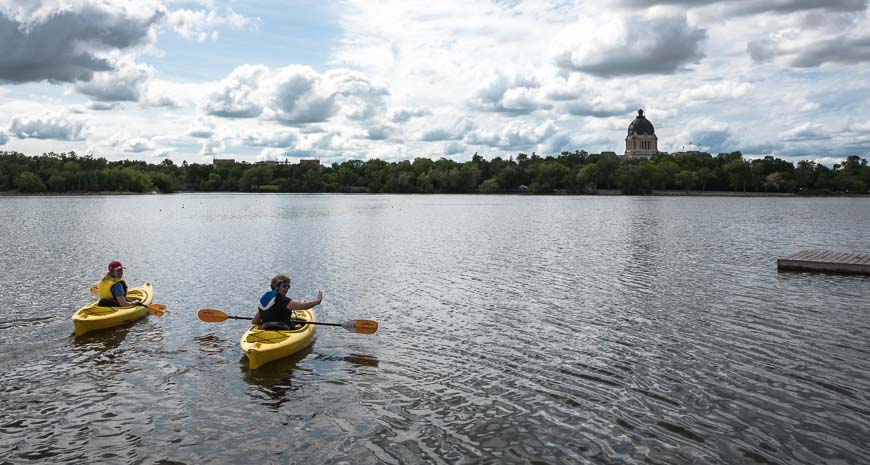
Kayaking on Wascana Lake in Regina
24. The beautiful Saskatchewan Legislative Building in Regina cost 1.75 million US dollars to build. It was built in the Beaux Art style over four years beginning in 1908. In 2005 the legislative building and its grounds were designated a National Historic Site of Canada. Tours focusing on the history and architecture of the building take place seven days a week. You can get more information here.
25. Thomas Walter Scott, whose statue is on the grounds, was the first premier of Saskatchewan with his term running from 1905-1916.

The Saskatchewan Legislative Building
25. The Queen Elizabeth II Gardens offer gorgeous flower displays during the spring and summer. Every year approximately 25,000 annuals are planted in the garden. The rest of the Legislature grounds aren’t forgotten. Another 5,000 flowers are planted throughout the grounds. It’s really a beautiful sight.
26. I stayed at the lovely Hotel Saskatchewan on my visit but not in the bullet proof Royal Suite. Famous guests include Queen Elizabeth II, Paul McCartney, Bill Clinton and Jon Bon Jovi.
27. Every day at 5 PM in the well-appointed lobby bar in the Hotel Saskatchewan you can get a taste of what it was like to be naughty back in the time of American Prohibition. Listen for the bell followed by a toast. Then its shots of whiskey all-round. If you order their Prohibition Tea you’ll get a boozy drink that looks like tea served in a proper teacup like your grandmother had.

Enjoying a cup of Prohibition tea at the Hotel Saskatchewan
28. Some of the famous people from Regina include Erik Nielsen (lawyer and politician), Ralph Goodale (lawyer and politician), Jordan Eberle (NHL hockey all-star), Julia Voth (actress & model), Justin Warsylewicz )Olympic speed skating silver medalist), Lucas Markian Makowsky (Olympic speed skating gold medalist), Ryan Getzlaf (NHL hockey all-star), Ben Hebert (Olympic curling gold medalist), Atina Ford, Olympic curling gold medalist (born Oct. 12, 1971), Mark McMorris (X-Games snowboarding champion) and Leslie Nielsen (a Canadian- American actor).
29. The First Nations University of Canada, specializing in indigenous knowledge is located in Regina. Both Indigenous and non-Indigenous students alike can attend the university.
Other post-secondary institutions include the University of Regina, Graduate School of Public Policy University of Regina, Western Christian College, Campion College and the Saskatchewan Institute of Applied Science and Technology, Wascana.

The First Nations University of Canada
Click on the photo to bookmark to your Pinterest boards.

The post 29 Fun and Interesting Facts about Regina appeared first on Hike Bike Travel.
29 Fun and Interesting Facts about Regina Read More »